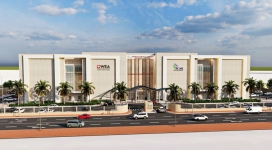
When a group of Israeli archaeologists were doing their usual pre-construction examination of the land near Mount Carmel, they unearthed a biblical artifact from Herod's Second Temple adorned with images of the menorah.
The northern Israeli mountain area just outside of Haifa was being surveyed for a water reservoir, but because the land holds so much important history, it is required to be examined by archaeologists before any work begins. But when the diggers discovered what was believed to be an ancient trash pit from the late Roman and Byzantine periods around the end of the fourth century A.D., an unimaginable treasure was hiding inside.
Amongst some fragments of glass, the researchers found a remnant of a bracelet showing an image of the traditional Jewish symbol known as the menorah. Excavation directors Limor Talmi and Dan Kirzner released a statement on their find, saying that they were "excited to discover that the bracelet, which is made of turquoise colored glass, is decorated with symbols of the seven-branched menorah - the same menorah which according to tradition was kept alight in the Temple for eight days by means of a single cruse of oil."
Two candelabras were distinguishable after the glass was carefully cleaned, showing "one a plain seven-branched menorah, of which only the surface of the menorah is visible and the other one consisting of a seven-branched menorah with flames depicted above its branches."
The reason this symbol is so important has to do with its reference in Exodus 25 verses 31 through 33 where God instructs Moses on the exact creation of the Ark of the Covenant and the golden lampstand. "You shall make a lampstand of pure gold. The base and the shaft of the lampstand shall be made of hammered work; its cups, its calyxes, and its petals shall be of one piece with it; and there shall be six branches going out of its sides, three branches of the lampstand out of one side of it and three branches of the lampstand out of the other side of it; three cups shaped like almond blossoms, each with calyx and petals, on one branch, and three cups shaped like almond blossoms, each with calyx and petals, on the other branch-so for the six branches going out of the lampstand."
While the archaeologists aren't sure who lived in the area during that time, noting that it could have been Jews, Samaritans, Christians or Pagans, they believe that this jewelry indicates how prosperous they were.
"Jewelry such as this was found in excavations, usually in the context of funerary offerings. It is unusual to find such objects in settlement strata, and even rarer to discover them in an ancient refuse pit," said Yael Gorin-Rosen, head of the Ancient Glass Department at the Israel Antiquities Authority.
"Glass jewelry was used extensively in the late Roman period and we can reasonably assume that those items that were specially decorated were more expensive than the plain unornamented ones," he continued. "The refuse that was discovered in the pit included numerous glass vessels and fragments of glass window panes, as well as a selection of jewelry, indicating of a population that lived a life of comfort and affluence."







